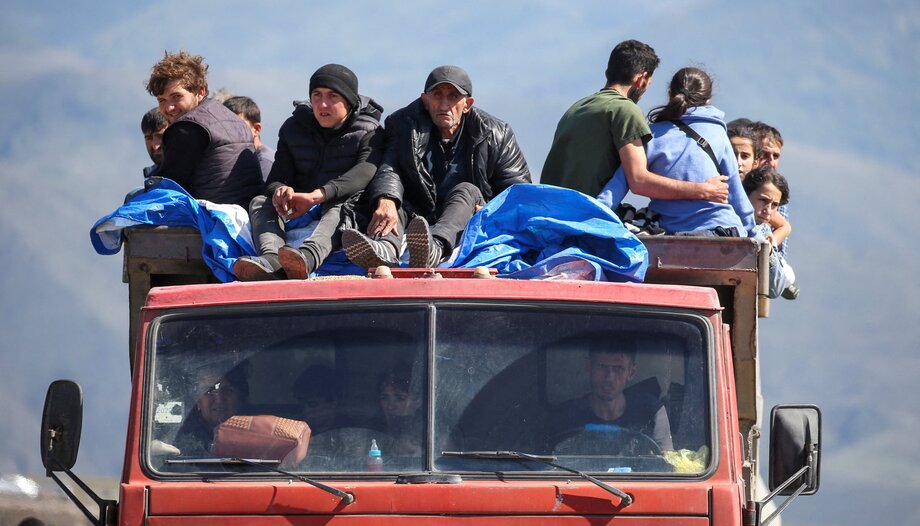Small and plagued by genocide, war and barbarism throughout its history, Armenia often goes unnoticed in the international media. It is, however, at a crossroads of countries and cultures that make it strategically important for powers such as Russia, Turkey and Israel.
Armenia, the world's first Christian nation
Many of the territories that appear in the Bible can be easily recognized today. Armenia is one of them: it is in the first book of the Bible, Genesis, where "the mountains of Ararat" (Armenians) appear, which Noah sees when he descends with his family and all the animals from the Ark, after the flood. According to Tradition, two of Jesus' disciples, St. Jude Thaddeus and St. Bartholomew, would later go to those lands - still pagan - to spread the Christian message after the death and resurrection of Christ. They were the ones who founded the Armenian Church although they suffered martyrdom for it.
The official conversion of Armenia as a Christian nation took place in 301 A.D., thanks to St. Gregory the Illuminator, who got the Armenian king Tiridates III to convert, together with all his people, and proclaimed it a state religion (even before the Edict of Milan, in 313, by which the Roman Empire stopped persecuting Christianity, and the Edict of Theodosius, with which in 380 the Empire recognized Christianity as a state religion).
Since then, the nation of Armenia has always been Christian and has lived in peace in an environment of countries of Islamic culture and religion. Unfortunately, this has been changing in recent years due to wars with Azerbaijan and political tensions with neighboring countries.
The truth is that the place where most of the Armenian people are concentrated today - because the rest are in exile in various parts of the world - is small compared to the great Armenian empire of antiquity. In fact, the Armenians were not only present in the current Republic of Armenia, but also constituted a quite powerful minority, in what today is known as Naxiçevan (autonomous region of Azerbaijan), in Javan (now part of Georgia), and in Artsakh (also known as Nagorno-Karabakh), a mountainous territory that is physically located in Azerbaijan, although its population is -or was, until recently- of Armenian majority.
The origins of the conflicts: the Armenian genocide and the division of territories after the dissolution of the Soviet Union
In the context of World War I, the Ottoman Empire took the opportunity to try to create a homogeneous state composed only of Muslim Turks, so they exterminated - or expelled - Armenians, Assyrians and Greeks. The Armenian genocide refers to the systematic massacre and deportation of Armenian citizens by the Ottoman Empire between 1915 and 1923. This tragic event resulted in the death of between one and a half and two million people. The Armenian massacre is a sensitive issue and has been recognized by several countries and international organizations as an act of genocide while Turkey still refuses to acknowledge the facts and is a reason for deteriorating or even breaking diplomatic relations with those countries that claim that this is -genocide- the appropriate word to describe the persecution suffered by the Armenian people.
Secondly, in 1923, the USSR, by annexing the two countries (Armenia and Azerbaijan) created several administrative borders in the area without respecting the real territorial boundaries of these countries, leaving Armenia between two Azeri territories and granting the Nagorno-Karabakh region a status of autonomy independent of Azerbaijan. With the dissolution of the Soviet Union, the administrative borders became real borders, giving rise to invasions and armed clashes between the two countries in a struggle for the territories of Nagorno-Karabakh - geopolitically important for powers such as Russia, Turkey, Iran or China. The last of the military offensives on the territory took place last September 2023.
Nagorno-Karabakh was inhabited mostly by the Armenian population, although internationally the territory is recognized today as a legitimate part of Azerbaijan. "This is a territorial conflict, not a religious one," Tirayr Hakobyan, Archimandrite of the Armenian Apostolic Church, explained to Omnes, "territory is important for peoples. After thousands of years living in a territory, that people want to remain there, because it is the place where they were born, where they have always lived, where they have seen their culture take root and where they have practiced their faith, built their churches... That is where they want to live and see their children grow up."
What Tirayr Hakobyan fears is that Azerbaijan seems determined to reclaim that area and erase all traces of Armenians and their culture. "They besieged the region without water and food for 10 months. They were about 100,000 Armenians, of whom 30,000 were children. In 24/48 hours they forced them out of their homes without being able to take anything but the clothes on their backs. They entered the houses and destroyed everything they found." Thus, the 100,000 Armenians left Nagorno-Karabakh, leaving behind their homes, their belongings, their churches and their territory, and went to seek shelter in Armenia. "Our country, being small and not having many resources, has also entered into a crisis because of all these people who arrived from Nagorno-Karabakh that we cannot take care of," laments Archimandrite Tirayr.
Christian faith, sustenance and identity of the Armenian people
Despite all these sufferings and war conflicts with surrounding non-Christian countries, Armenia has not taken "one step back" in its faith. Somehow this loyalty has been rewarded in a special way, at least twice (despite diplomatic challenges), with the visit of two Pontiffs: Pope John Paul II, who visited Armenia in 2001 and Pope Francis in 2016. The Pope first expressed his desire to travel to the country in 2015, just as the 100th anniversary of the Armenian Genocide was being marked. On April 12 of that same year, Pope Francis named St. Gregory of Narek a doctor of the Church in a ceremony officiated in memory of the 100th anniversary of the genocide.
Currently, the Armenian people are scattered all over the planet: of the 12 million Armenians that exist, only 3 million are in Armenia. The rest are scattered all over the world in large communities, such as in France, for example, or smaller ones, such as in the United States, Italy, Greece, Kuwait, Qatar, Oman or Dubai. There are many Armenian communities living in Muslim countries where they live in peace with Islamic beliefs and customs. "Despite being outside their territories, our brothers continue to maintain their creed, and the first thing they do when they arrive in a new country is to build a Church, in order to be able to live the faith where they are, because it is part of our identity. Language is also a symbol that unites us: we all speak Armenian, whether we were born in the United States, in Lebanon or in the nation of Armenia itself".
The Armenian Church, autocephalous and independent
The Armenian Church has been an independent church from the Catholic Church since 451, the year of the Council of Chalcedon, which established the dual nature, human and divine, of Christ. The advocates of monophysitism (one nature of Christ) then separated from the Catholic Church, forming a parallel Christian Church.
The Armenian Church is autocephalous, i.e., it has its own head, the CatholicósThe Church is completely independent of the ecclesiastical hierarchies of the other confessions, although it has always maintained good relations in an ecumenical spirit with the Orthodox, Catholic and Protestant Churches.
Likewise, it defines itself as both Orthodox and Catholic, since it considers that it is an expression, on the one hand, of the true Christian faith, and, on the other hand, of the universality of the Church. In December 1996 St. John Paul II and His Holiness the Catholicos of all Armenians, Karekin II, signed a joint declaration affirming the common origin of the Armenian Church and the Roman Catholic Church.













